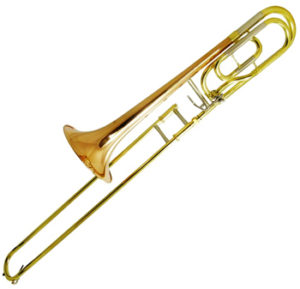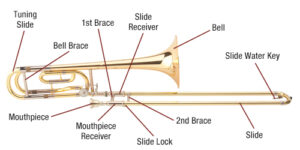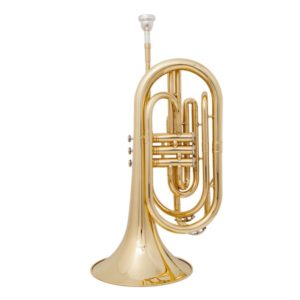Contents
- 1 Mastering the Art of the Trombone
- 1.1 History and Evolution of the Trombone
- 1.2 Different Types of Trombones
- 1.3 Anatomy and Components of the Trombone
- 1.4 Getting Started with the Trombone
- 1.5 Basic Techniques for Playing the Trombone
- 1.6 Intermediate and Advanced Trombone Techniques
- 1.7 Tips for Improving your Trombone Playing
- 1.8 Common Challenges and How to Overcome Them
- 1.9 Conclusion to Mastering the Art of the Trombone
Mastering the Art of the Trombone
Learn to produce soul-stirring melodies and unleash your creative potential with the timeless instrument – the trombone. In this article, we delve into the art of mastering the trombone and uncover the secrets to becoming a virtuoso.
 Whether you’re a beginner embarking on your musical journey or an experienced player looking to refine your skills, this comprehensive guide has something for everyone. Discover the correct embouchure technique, breath control, and finger positioning, along with tips to develop your tone and manage slide positions effortlessly. Delve into the history and evolution of the trombone, from its humble beginnings in Renaissance music to its prominent role in jazz and orchestral performances today.
Whether you’re a beginner embarking on your musical journey or an experienced player looking to refine your skills, this comprehensive guide has something for everyone. Discover the correct embouchure technique, breath control, and finger positioning, along with tips to develop your tone and manage slide positions effortlessly. Delve into the history and evolution of the trombone, from its humble beginnings in Renaissance music to its prominent role in jazz and orchestral performances today.
Explore the various styles and genres where the trombone shines, and learn how to adapt your playing to the demands of different musical contexts. Mastering the trombone is not just about learning the technical aspects; it’s about communicating emotions and telling stories through your instrument. Join us as we unravel the secrets, techniques, and nuances of this majestic brass instrument. Get ready to elevate your playing and captivate audiences with the magical sound of the trombone.
History and Evolution of the Trombone
The trombone is a brass instrument that has been around for centuries. It is one of the few instruments that can change its pitch by moving a slide, rather than using valves or keys. The trombone evolved from an earlier instrument called the sackbut, which was used in the Renaissance and Baroque periods. The sackbut had a smaller bore and a less flared bell than the modern trombone, and it produced a softer and more mellow sound.
The trombone became more popular in the 18th and 19th centuries, when composers such as Mozart, Beethoven, Schubert, and Wagner wrote for it. The trombone also played an important role in jazz music, especially in the swing era, when trombonists such as Tommy Dorsey, Glenn Miller, and Jack Teagarden became famous. Today, the trombone is used in various musical genres, from classical to rock to pop, and it has many different types and sizes, such as the alto, tenor, bass, and contrabass trombones.
Different Types of Trombones
Trombones are brass instruments that produce sound by vibrating the lips on a mouthpiece and sliding a tube to change the pitch. There are different types of trombones, such as the tenor trombone, the bass trombone, the alto trombone and the soprano trombone. Each type has a different range, size and tone quality. The tenor trombone is the most common and versatile type, while the bass trombone has a lower and richer sound. The alto trombone is smaller and higher-pitched than the tenor, and the soprano trombone is the smallest and highest-pitched of all.
Anatomy and Components of the Trombone

The trombone is a brass instrument that produces sound by vibrating the lips on a mouthpiece and changing the length of a metal tube with a slide. The trombone has three main parts: the mouthpiece, the slide and the bell.
- The mouthpiece is where the player blows air into the instrument.
- The slide is a U-shaped tube that can be moved in and out to adjust the pitch of the sound.
- The bell is the flared end of the tube that amplifies the sound and directs it outward.
Getting Started with the Trombone
The trombone is a brass instrument that produces sound by vibrating the lips on a mouthpiece and changing the length of a metal tube with a slide. To get started with the trombone, you will need a few things: a trombone, a mouthpiece, a music stand, some sheet music, and a tuner. Here are some steps to follow:
- Assemble the trombone by attaching the slide to the bell section and inserting the mouthpiece into the receiver.
- Hold the trombone with your left hand on the brace near the bell and your right hand on the slide. Make sure your posture is straight and relaxed.
- Place the mouthpiece on your lips and blow air through it. Try to make a buzzing sound with your lips. This is called embouchure.
- Move the slide in and out to change the pitch of the sound. There are seven positions on the slide, each corresponding to a different note. Use a tuner to check your intonation.
- Practice playing some simple melodies or scales with the trombone. You can find some beginner sheet music online or in books. Follow the instructions for fingering, articulation, and dynamics.
- Enjoy playing the trombone and have fun!
Basic Techniques for Playing the Trombone
The trombone is a brass instrument that produces sound by vibrating the lips on a mouthpiece and changing the length of the tube with a slide. Here are some basic techniques for playing the trombone:
- To produce a good tone, you need to breathe deeply and use your diaphragm to support the air flow. You also need to relax your lips and keep them slightly apart on the mouthpiece.
- To change the pitch, you need to move the slide in and out while keeping the same lip tension. The slide has seven positions, each corresponding to a different note. You can use a tuner or a piano to check your intonation.
- To articulate the notes, you need to use your tongue to start and stop the air stream. You can practice different tonguing patterns, such as single, double, or triple tonguing, to improve your speed and clarity.
- To play with dynamics, you need to adjust the volume of your sound by changing the amount of air you use. You can also use crescendos and diminuendos to create musical expression.
Intermediate and Advanced Trombone Techniques
If you want to take your trombone playing to the next level, you need to master some intermediate and advanced techniques. Here are some tips to help you improve your skills:
- Practice your scales and arpeggios in all keys and positions. This will help you develop your intonation, flexibility, and range.
- Learn how to use alternate positions and slide techniques. This will allow you to play faster passages, smoother legato, and more expressive articulations.
- Experiment with different mutes and effects. This will add variety and color to your sound and expand your musical vocabulary.
- Study different styles and genres of music. This will expose you to different rhythms, melodies, and harmonies and broaden your musical horizons.
- Listen to and emulate great trombone players. This will inspire you and help you develop your voice and style.
Tips for Improving your Trombone Playing
If you want to improve your trombone playing, here are some tips that might help you. First, practice regularly and consistently. It’s better to practice for a short time every day than to cram for hours once a week. Second, work on your breathing and posture. Breathing deeply and correctly will help you produce a better sound and avoid fatigue. Posture is also important for your comfort and tone quality. Third, listen to other trombone players, especially the ones you admire. You can learn a lot from their style, technique and expression. Try to imitate them or play along with them. Finally, have fun and enjoy playing the trombone. Don’t be too hard on yourself or compare yourself to others. Playing music should be a rewarding and enjoyable experience.
Common Challenges and How to Overcome Them
Life is full of challenges, but they don’t have to stop you from achieving your goals. Here are some common challenges and how to overcome them:
- Lack of motivation: Sometimes you may feel like you don’t have the energy or the interest to do anything. To overcome this, try to find something that inspires you, such as a role model, a vision, or a reward. Remind yourself of why you are doing what you are doing and how it will benefit you in the long run.
- Fear of failure: Sometimes you may be afraid to take risks or try new things because you don’t want to fail. To overcome this, try to see failure as a learning opportunity, not a personal flaw. Learn from your mistakes and use them to improve your skills and strategies. Remember that everyone fails at some point, but what matters is how you bounce back.
- Procrastination: Sometimes you may put off doing something important or difficult because you don’t feel like it or you are distracted by other things. To overcome this, try to break down your tasks into smaller and more manageable steps. Set deadlines and rewards for yourself and stick to them. Avoid distractions and focus on one thing at a time.
Conclusion to Mastering the Art of the Trombone

The trombone is a versatile and expressive instrument that can enrich any musical genre. Mastering the art of the trombone requires dedication, practice and passion. By following these tips and techniques, you will be able to improve your tone, range, intonation and musicality. You will also learn how to play with confidence, expression and creativity. Whether you are a beginner or an advanced player, this book will help you achieve your trombone goals and enjoy the journey along the way.
